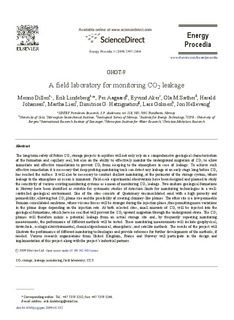A field laboratory for monitoring CO2 leakage
Dillen, Menno; Lindeberg, Erik Gøsta Brun; Aagaard, Per; Aker, Eyvind; Sæther, Ola Magne; Johansen, Harald; Lien, Martha; Hatzignatiou, Dimitrios Georgios; Golmen, Lars Gunder; Hellevang, Jon Oddvar
Journal article
Permanent lenke
http://hdl.handle.net/11250/2425006Utgivelsesdato
2009Metadata
Vis full innførselSamlinger
- NGI articles [1061]
Sammendrag
The long-term safety of future CO2 storage projects in aquifers will not only rely on a comprehensive geological characterisation of the formation and capillary seal, but also on the ability to effectively monitor the underground migration of CO2 to allow immediate and effective remediation to prevent CO2 from escaping to the atmosphere in case of leakage. To achieve such effective remediation it is necessary that deep-probing monitoring tools can detect any leakage at an early stage long before CO2 has reached the surface. It will also be necessary to conduct shallow monitoring, at the perimeter of the storage system, where leakage to the atmosphere or ocean is imminent. Field-scale experimental observations have been designed and planned to study the sensitivity of various existing monitoring systems as a mean of monitoring CO2 leakage. Two onshore geological formations in Norway have been identified as suitable for systematic studies of detection limits for monitoring technologies in a wellcontrolled geological environment. One of the sites consists of Quaternary unconsolidated sand with a high porosity and permeability, allowing fast CO2 plume rise and the possibility of creating chimney-like plumes. The other site is a low-permeable Permian consolidated sandstone, where viscous forces will be stronger during the injection phase, thus permitting more variations in the plume shape depending on the injection rate. At both selected sites, small amounts of CO2 will be injected into the geological formations, which have no seal that will prevent the CO2 upward migration through the underground strata. The CO2 plumes will therefore mimic a potential leakage from an actual storage site and, by frequently repeating monitoring measurements, the performance of different methods will be tested. These monitoring measurements will include geophysical, down-hole, ecological/environmental, chemical/geochemical, atmospheric, and satellite methods. The results of the project will illustrate the performance of different monitoring technologies and provide reference for further developments of the methods, if needed. Various research organisations from United Kingdom, France and Norway will participate in the design and implementation of this project along with the project’s industrial partners.
Beskrivelse
-
